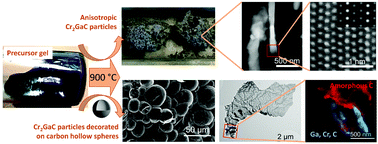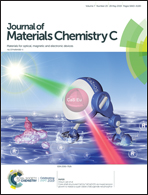Sol–gel based synthesis and enhanced processability of MAX phase Cr2GaC†
Abstract
MAX phases are typically prepared by high-temperature (oftentimes high-pressure) solid-state methods. Here, we report a new wet chemistry based synthesis technique starting from an aqueous solution of metal nitrates and citric acid to prepare MAX phase Cr2GaC. This solution-processable precursor mixture has the potential to be easily scaled, painted, printed or fabricated onto supports – an advantage that is demonstrated by the formation of hollow carbon microspheres which are decorated with Cr2GaC particles. A small amount of chromium carbide and oxide remains in the product, however, the amount of the latter can be reduced by a larger excess in citric acid in the precursor gel. The transformation mechanism of the initial amorphous gel into highly crystalline and anisotropic MAX phase particles is investigated by detailed thermal analysis. Transmission electron microscopy studies are conducted to elucidate the microstructure of the sol–gel-prepared particles as well as the decorated hollow microspheres. From magnetic susceptibility measurements, the density of states at the Fermi level is deduced reflecting the quality of the Pauli paramagnet Cr2GaC.



 Please wait while we load your content...
Please wait while we load your content...